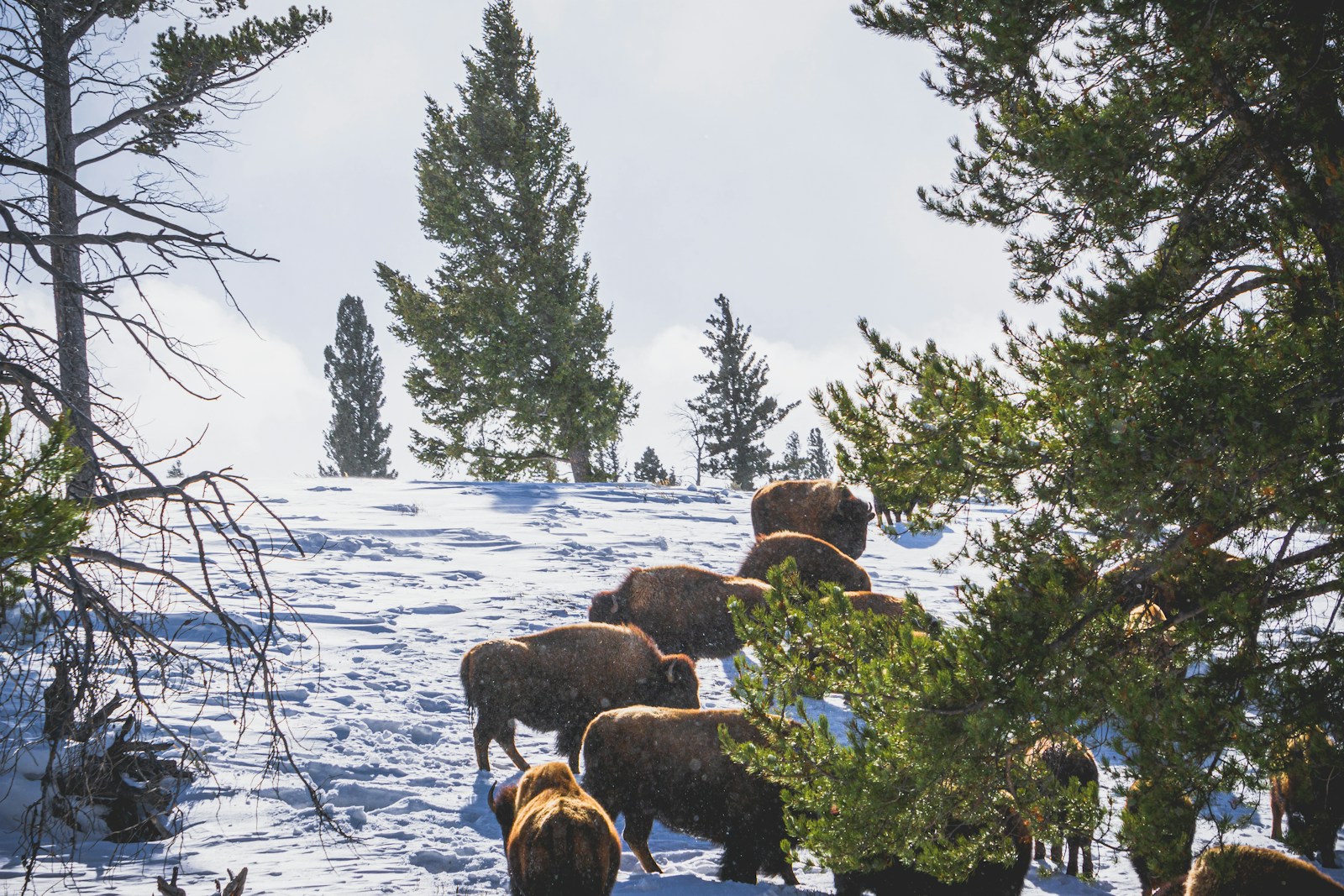The American bison, majestic symbols of the North American wilderness, have roamed the Great Plains for thousands of years, developing remarkable adaptations to survive some of the harshest winter conditions on the continent. When blizzards sweep across the plains with temperatures plummeting to -40°F, most creatures would perish, yet bison not only endure but thrive in these challenging environments. Their survival story is a testament to evolutionary perfection—from specialized physical traits to behavioral adaptations that have allowed these massive mammals to weather brutal winters long before humans settled the region. Understanding how these iconic animals navigate the frigid months reveals not just their resilience but also provides insights into the delicate balance of prairie ecosystems and the remarkable ways nature equips its creatures to face extreme conditions.
The Insulating Power of Bison Fur
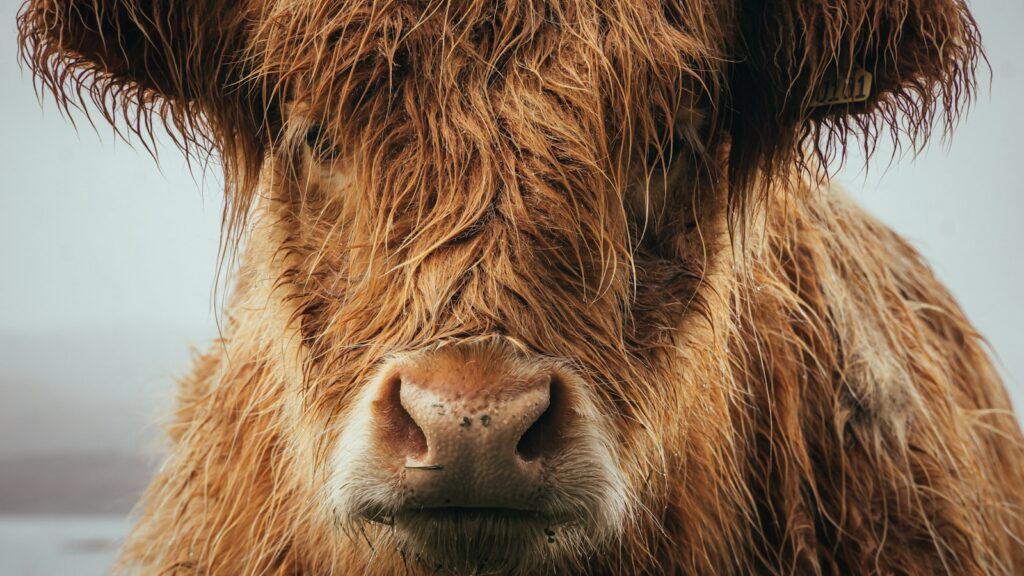
Bison possess one of nature’s most effective winter coats, featuring multiple layers that provide exceptional insulation against frigid temperatures. The outer layer consists of long guard hairs that can grow up to 2 inches on the body and reach an impressive 12-16 inches around the forehead, shoulders, and front legs, creating the distinctive “beard” and shaggy appearance. Beneath this outer layer lies a dense undercoat of soft, wool-like fur that traps warm air close to the skin, creating a natural barrier against even the most biting winter winds. This specialized coat is so effective that snow can accumulate on a bison’s back without melting, indicating minimal heat loss from their massive bodies. During winter, the fur reaches its maximum thickness and insulating capacity, with studies showing it provides nearly three times more insulation than the winter coats of domestic cattle.
Massive Bodies: Nature’s Heat Retention Strategy
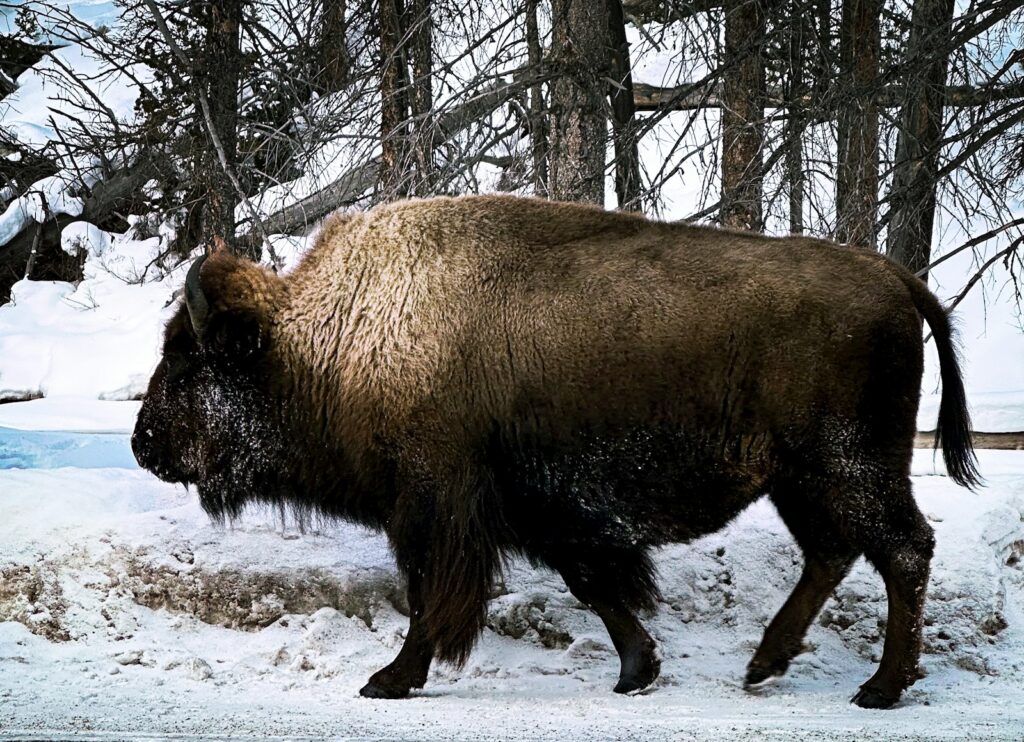
The impressive size of bison serves as a crucial adaptation for winter survival, operating on the principle that larger bodies retain heat more efficiently than smaller ones. Adult bulls can weigh up to 2,000 pounds and stand six feet tall at the shoulder, while females typically reach about 1,000 pounds—dimensions that create a favorable surface area-to-volume ratio for conserving body heat. This biological principle means that as body size increases, the amount of heat-losing surface area relative to heat-generating volume decreases, allowing bison to maintain their core temperature with less energy expenditure. Their barrel-shaped torsos minimize the surface area exposed to cold winds while maximizing internal volume for vital organs. Additionally, bison concentrate fat reserves in specific areas of their bodies during fall, creating natural insulation that can be metabolized for energy during the leanest winter months when food becomes scarce beneath the snow.
Specialized Facial Features for Cold Protection
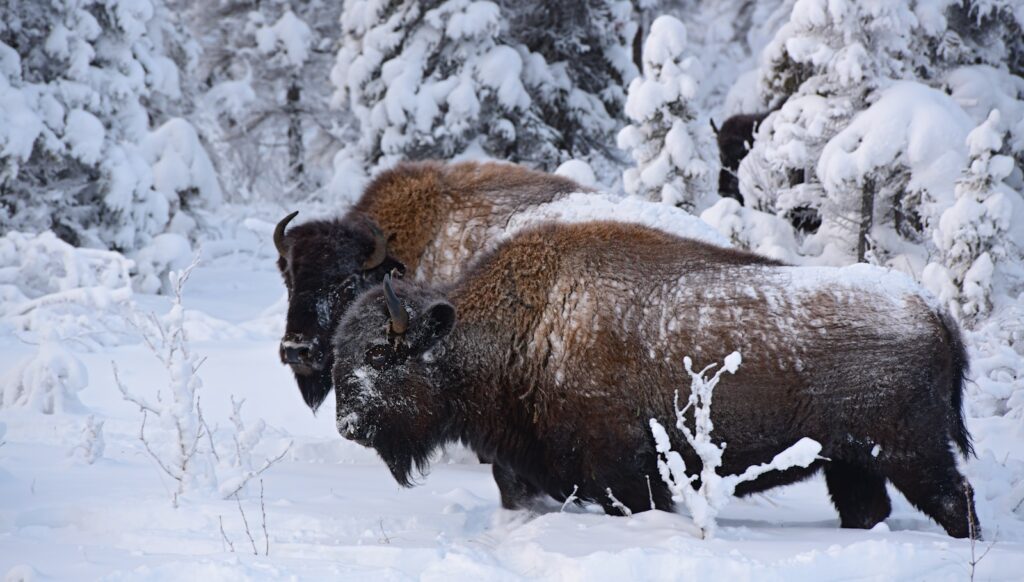
Bison faces display remarkable adaptations specifically evolved to handle extreme winter conditions on the Great Plains. Their eyes are positioned on the sides of their skull and protected by a heavy ridge of bone and thick fur that shields them from driving snow and harsh winds. The compact muzzle of a bison is notably smaller than might be expected for an animal of its size, minimizing exposed skin and reducing heat loss through the respiratory system. Their nostrils are designed to pre-warm frigid air before it reaches their lungs, preventing cold shock to their respiratory systems during the deepest winter chills. Perhaps most importantly, the thick fur covering much of their face—particularly the distinctive “beard” beneath their chin—provides crucial protection for their throat and neck region, areas where blood vessels run close to the surface and heat loss could otherwise be substantial.
Winter Foraging Techniques
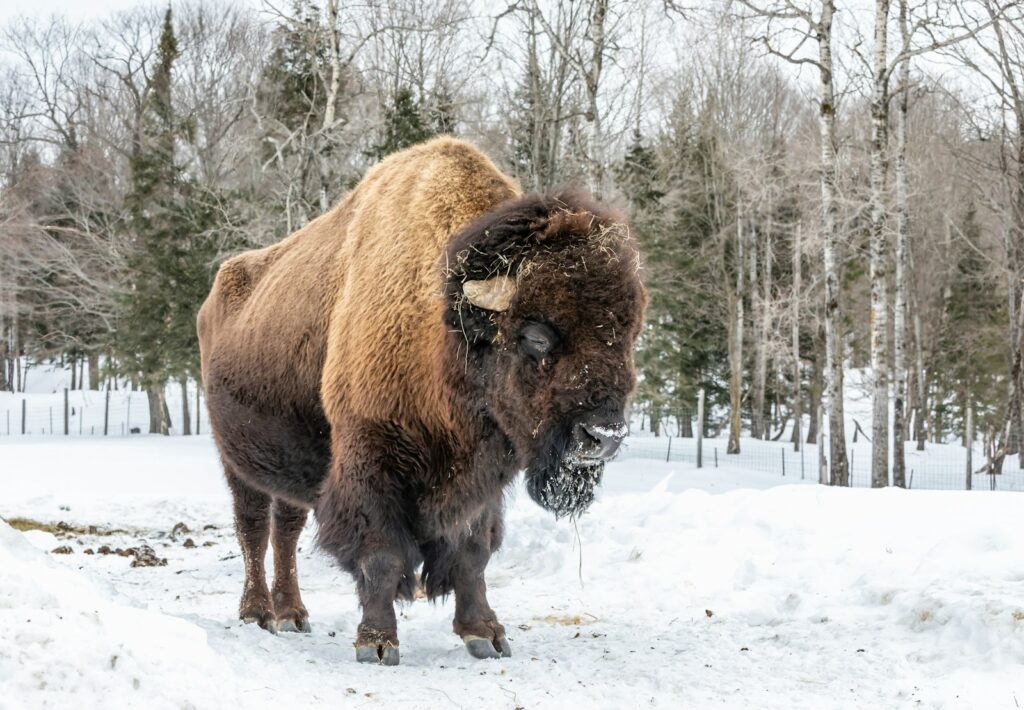
Bison have developed specialized foraging behaviors that allow them to access food sources buried beneath deep snow, a crucial skill when winter storms blanket the plains. Using their massive heads as natural snowplows, they swing their heads from side to side in sweeping motions to clear snow from patches of grass, a behavior known as “cratering.” Their tough, muscular necks provide the strength needed to move substantial amounts of snow, exposing the dormant vegetation beneath. Unlike deer or elk that paw at the snow with their hooves, bison’s head-sweeping technique clears larger areas more efficiently, giving them access to critical winter forage. Remarkably, bison can detect vegetation beneath up to three feet of snow, likely through a combination of scent detection and memory of productive grazing areas from previous seasons, allowing them to target their energy-intensive snow clearing in the most rewarding locations.
Metabolic Adaptations for Winter Survival
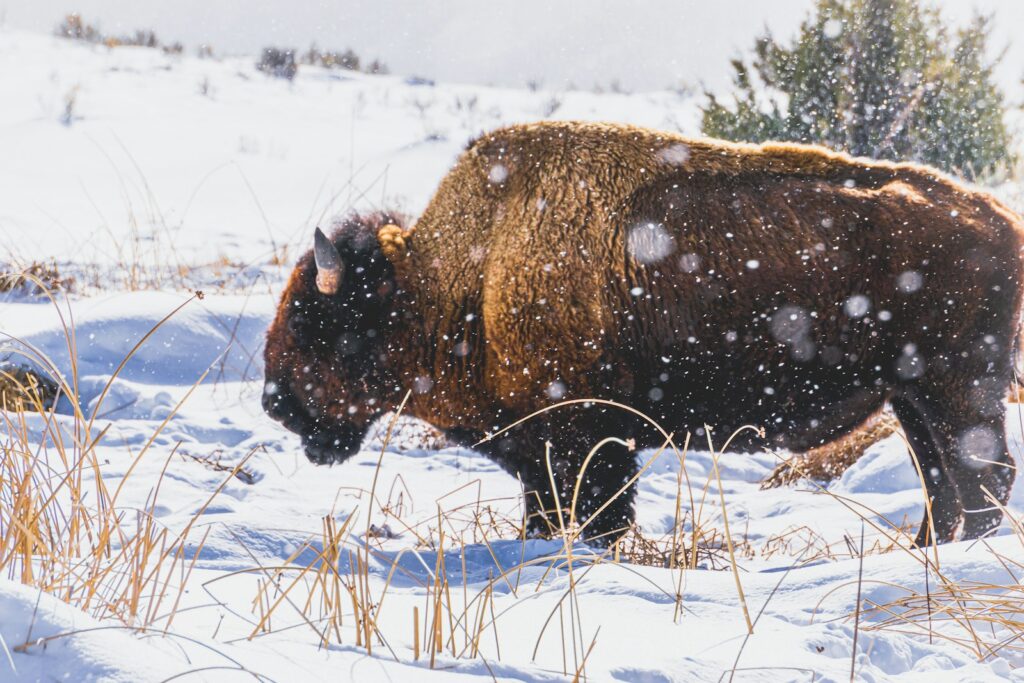
During winter months, bison undergo significant metabolic adaptations that help conserve energy when food resources are limited. Their basal metabolic rate decreases by approximately 30% compared to summer levels, effectively putting them into a modified state of conservation without entering true hibernation. This physiological adjustment means they require less food intake to maintain bodily functions during periods when calories are scarce. Bison also possess specialized digestive systems with enlarged rumens that allow them to extract maximum nutrition from low-quality winter forage high in cellulose, breaking down tough prairie grasses more efficiently than many other large mammals. Their digestive efficiency is further enhanced by longer food retention times in winter, allowing for more complete fermentation and nutrient extraction from each mouthful of forage. These metabolic adjustments, combined with the strategic use of fat reserves accumulated during summer and fall, create an energy management system precisely calibrated for surviving the resource-scarce winter months.
Strategic Movement Patterns
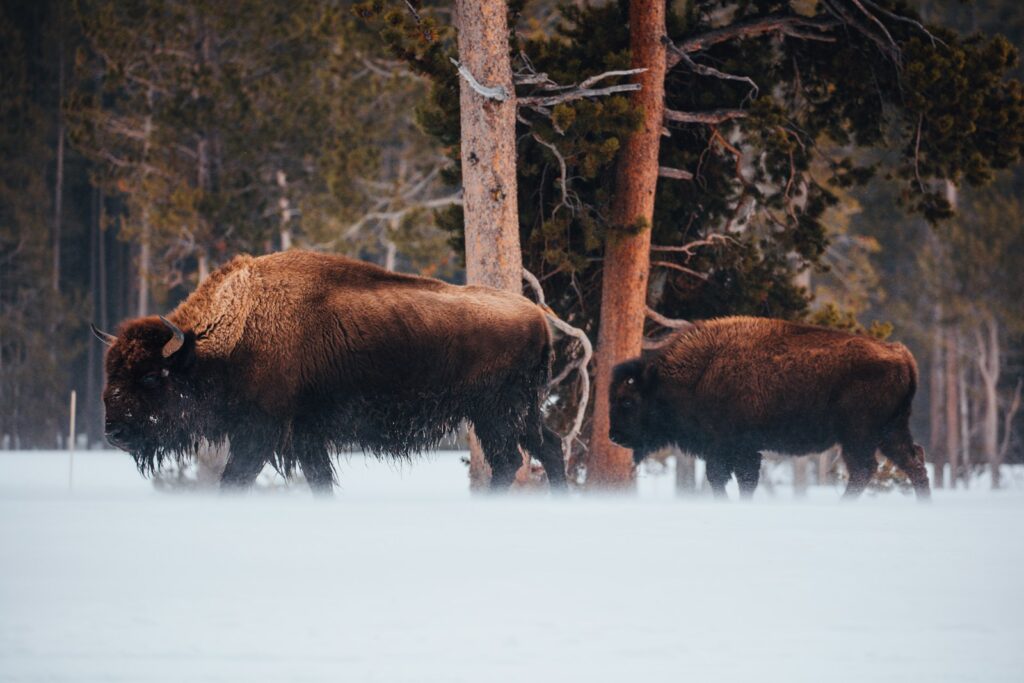
Bison employ sophisticated movement strategies during winter that maximize their access to food while minimizing energy expenditure. Rather than migrating vast distances like some species, most bison populations make smaller, tactical movements to microhabitats within their range, seeking south-facing slopes where snow is shallower and wind-swept ridges where vegetation remains exposed. Historical observations indicate that herds position themselves near natural windbreaks such as river valleys or bluffs during severe storms, then move to higher elevations where wind action has cleared snow from grazing areas. Research using GPS tracking has revealed that winter bison movements are approximately 50% reduced compared to summer wanderings, conserving precious energy when caloric intake is limited. This calculated approach to winter movement represents a finely tuned balance between the energy costs of travel through deep snow and the nutritional benefits of reaching better foraging grounds.
Communal Snow Management
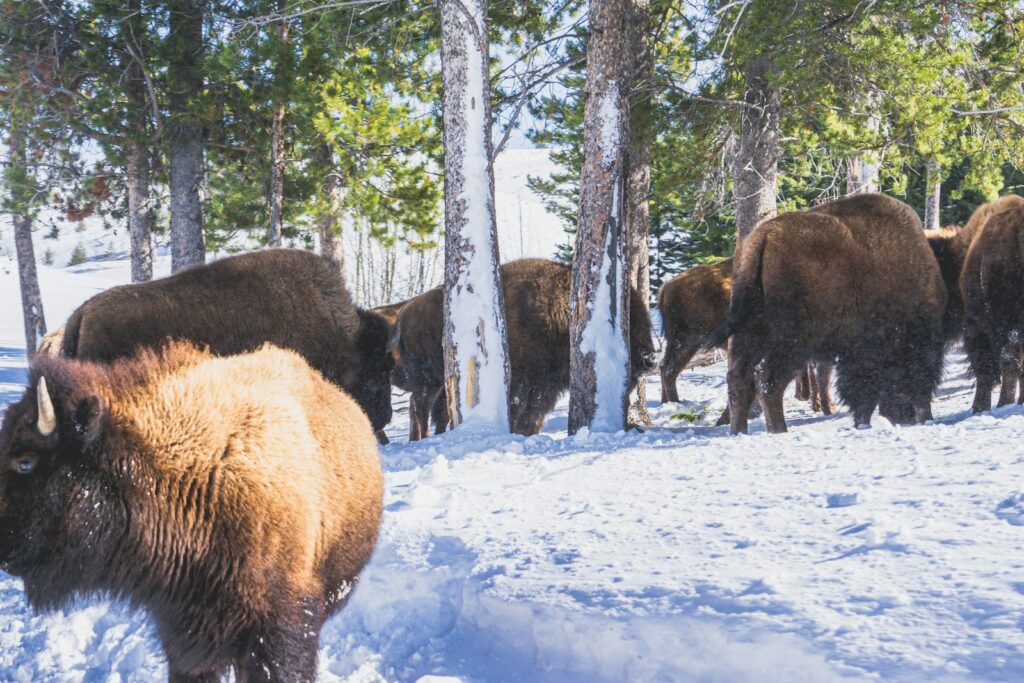
Bison have developed remarkable social behaviors that contribute significantly to their winter survival, particularly through cooperative snow management. When heavy snowfall occurs, herds often move in single-file formations with larger, stronger animals taking turns at the front position, breaking trail through deep snow to reduce energy expenditure for those following behind. This rotation of leadership distributes the energy-intensive work of path-breaking among multiple individuals, benefiting the entire group’s survival chances. The areas cleared by groups of foraging bison create communal feeding zones much larger than what individual animals could maintain, effectively multiplying the accessible grazing area for the entire herd. Research has documented that these communal grazing patches can remain productive for days, with the concentrated activity of multiple animals preventing new snow accumulation and allowing more efficient feeding for all herd members.
Thermal Regulation Through Snow Wallowing
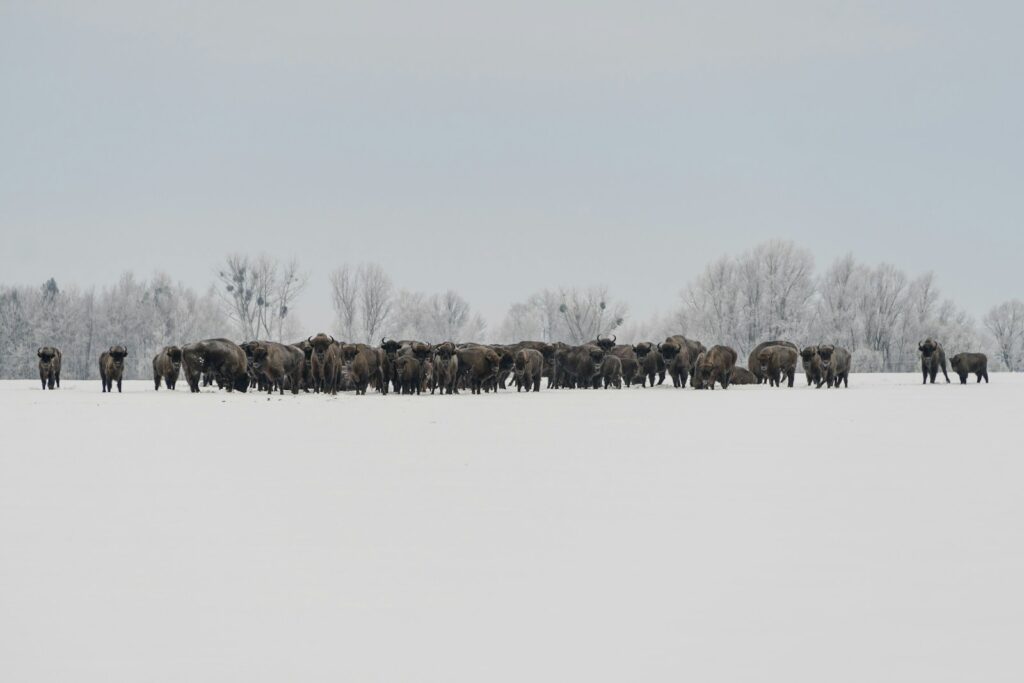
Counter to what might seem intuitive, bison engage in snow wallowing behaviors that serve important functions in their winter survival strategy. By deliberately rolling in snow, bison actually help maintain their thick fur’s insulating properties by removing debris, parasites, and excess moisture that could compromise their coat’s effectiveness. The mechanical action of wallowing fluffs their dense undercoat, increasing its loft and enhancing its ability to trap warm air close to the skin. Zoologists have observed that snow particles shake out of their fur more easily than rain or sleet, helping keep the insulating layer dry even in mixed winter precipitation. Additionally, this behavior may serve social functions within the herd, as wallowing sites often become communal locations where multiple animals participate in the activity, potentially strengthening group bonds during the challenging winter season.
Wind-Defying Orientation
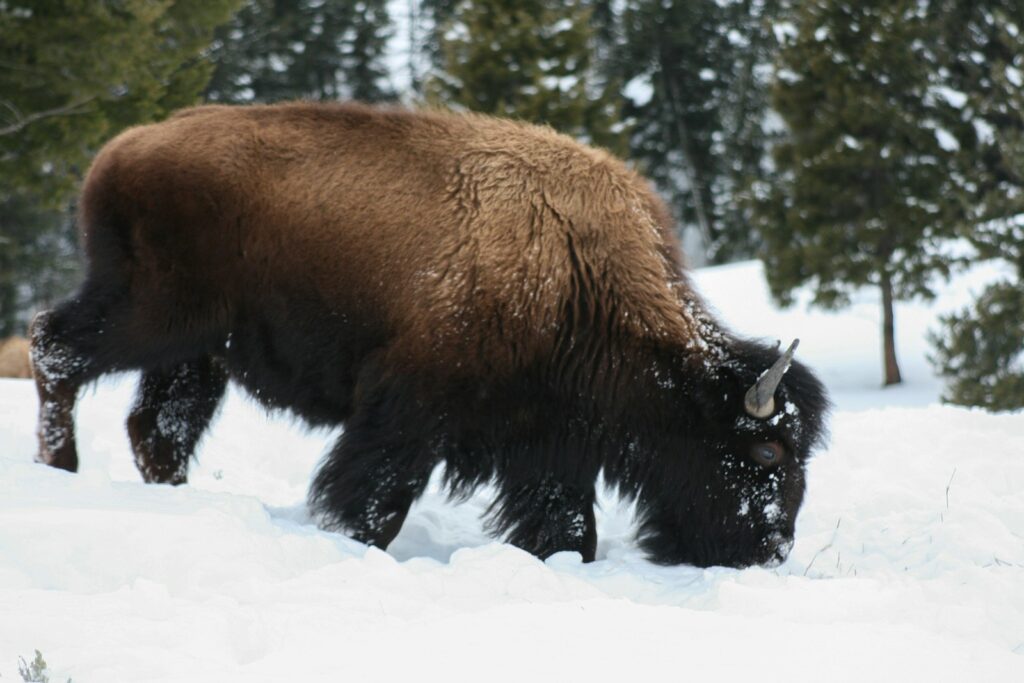
Bison display a distinctive behavioral adaptation to winter storms by positioning their bodies strategically in relation to wind direction. During intense blizzards or driving snowstorms, observers have documented bison turning to face directly into the wind rather than away from it, a counter-intuitive posture that offers several survival advantages. This head-on orientation prevents snow from accumulating in their thick fur around vital areas like the face and ears, maintaining visibility and hearing during storms. Their massive shoulder hump and densely furred head act as a natural windbreak for the rest of their body when positioned this way, creating a more streamlined profile that reduces heat loss. Wildlife biologists have recorded bison maintaining this position for hours during severe weather events, often standing completely still to conserve energy while their thick fur and forward-facing stance minimize the storm’s impact on their core temperature.
Cold-Adapted Circulation Systems
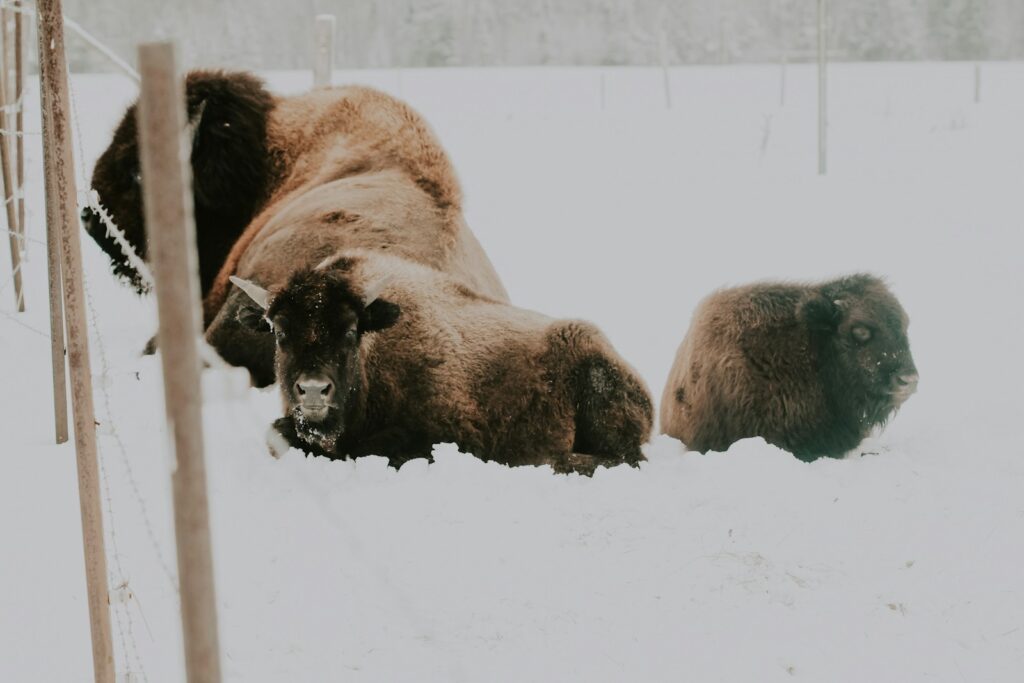
Bison possess specialized circulatory adaptations that prevent freezing damage to their extremities even in the most punishing winter conditions. Their cardiovascular system employs countercurrent heat exchange, where arteries carrying warm blood from the core run parallel to veins returning cooler blood from the extremities, allowing heat transfer between the vessels. This elegant system pre-warms blood returning from exposed areas like legs and ears before it reaches vital organs, preventing dangerous core temperature drops. In particularly extreme cold, bison can restrict blood flow to peripheral areas through vasoconstriction, prioritizing core temperature maintenance at the expense of extremities. Research has shown their legs can operate at temperatures much closer to freezing than their internal organs without suffering tissue damage, an adaptation shared with other cold-climate specialists like arctic wolves and caribou. This vascular engineering allows bison to stand in deep snow or on frozen ground for extended periods without risking frostbite or hypothermia.
Reduced Winter Water Requirements
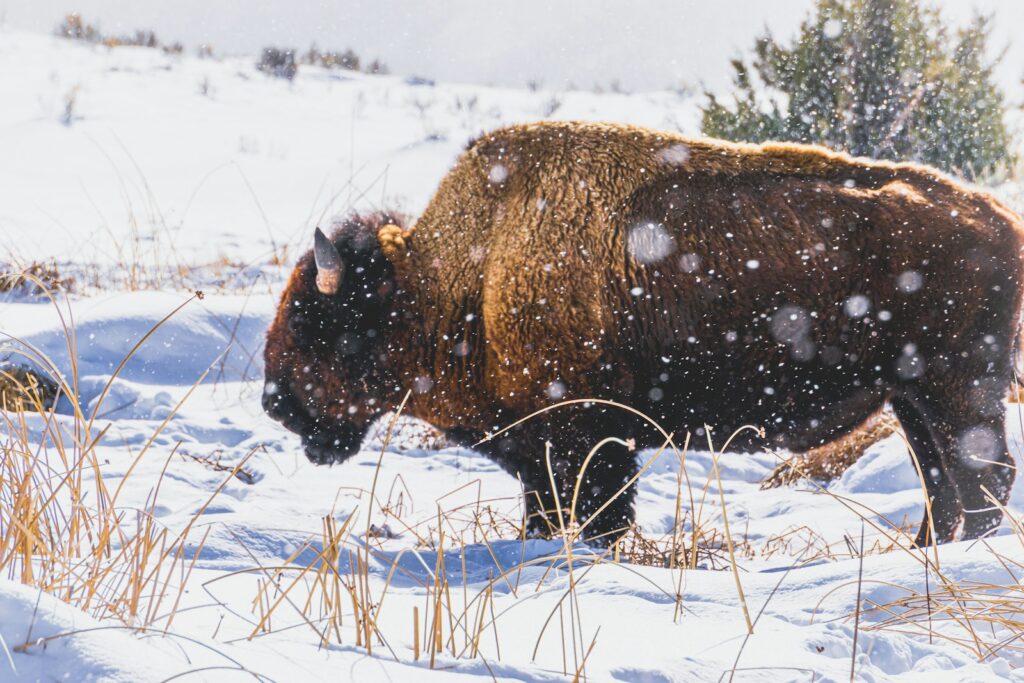
Bison have evolved physiological adaptations that significantly reduce their winter water needs compared to summer requirements, a crucial survival strategy when water sources freeze solid. Their bodies become more efficient at water conservation during winter months, with research indicating their daily water requirement may decrease by up to 30% compared to summer needs. When necessary, bison fulfill much of their hydration needs by consuming snow, converting it to water through body heat in a process that, while slightly energy-costly, eliminates the need to find open water sources. Their specialized winter diet of dried grasses with lower moisture content triggers kidney adaptations that concentrate urine and reduce water loss through excretion. This reduced dependency on liquid water sources represents a significant survival advantage during deep winter when temperatures may remain below freezing for weeks, transforming the plains into a landscape where flowing water becomes exceptionally scarce.
Reproductive Timing Synchronized with Seasons
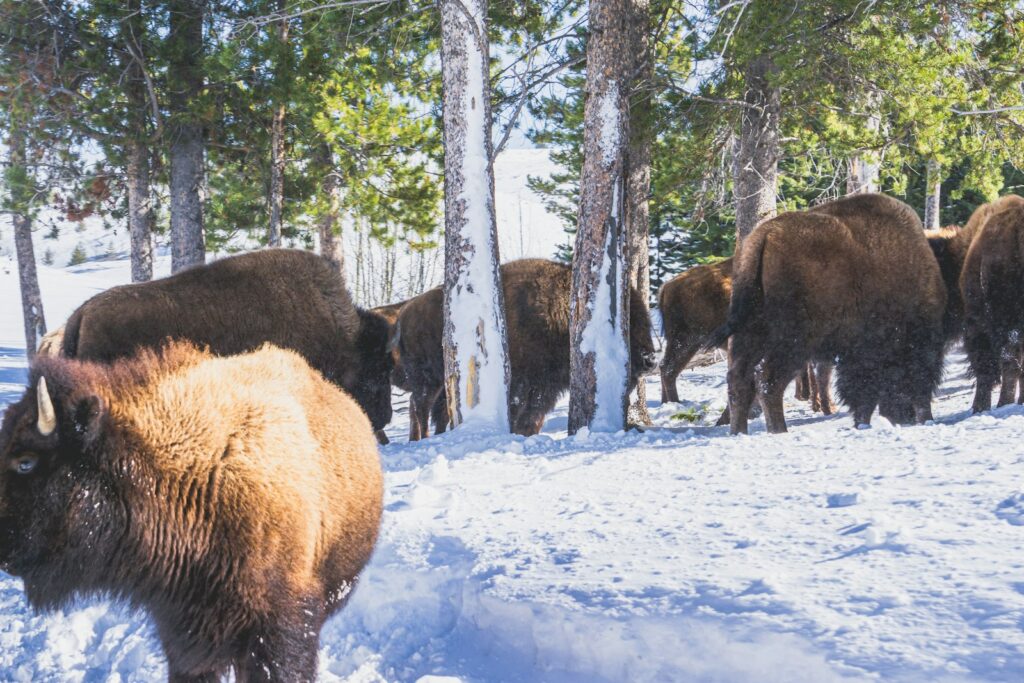
The reproductive cycle of bison is precisely calibrated to align with the harsh seasonal realities of Great Plains winters. Mating occurs during the late summer “rut” period, timing gestation so that calves are born in spring when temperatures moderate and nutritious new vegetation emerges. This strategic timing ensures that no calves face the challenging conditions of their first winter without several months of growth and fat accumulation. Female bison enter winter pregnant but in their first trimester, when fetal demands on the mother’s resources are minimal, allowing cows to prioritize their own survival during the resource-scarce winter months. The most energy-intensive period of late pregnancy and lactation coincides with the return of abundant spring and summer forage, ensuring mothers have sufficient nutritional resources for successful reproduction. This synchronized reproductive strategy represents thousands of years of evolutionary fine-tuning to the specific seasonal challenges of the Great Plains environment.
Historic Winter Survival Lessons from Bison
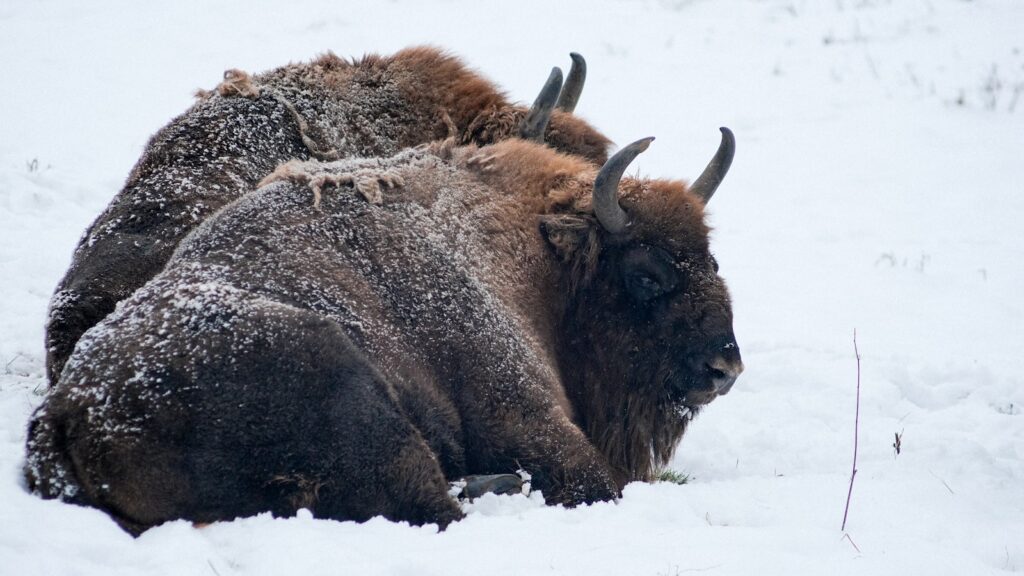
The winter survival strategies of bison offered critical lessons to indigenous peoples and early settlers of the Great Plains, creating a knowledge exchange that shaped human adaptation to this challenging environment. Native American tribes like the Lakota and Blackfeet carefully observed bison behavior to predict weather patterns, noting that certain movements often preceded major storms and incorporating these natural warnings into their own winter preparation practices. The insulating properties of bison hides and fur became essential components of winter survival for humans, with Plains tribes developing sophisticated processing techniques to maximize the warmth of robes and shelters made from these materials. Archaeological evidence indicates that many Plains settlements were positioned in locations that historically served as bison winter habitat, suggesting humans recognized and utilized the same landscape features that offered protection from harsh winter conditions. This relationship between bison winter adaptations and human survival strategies represents one of the most significant ecological knowledge transfers in North American history.
Conclusion
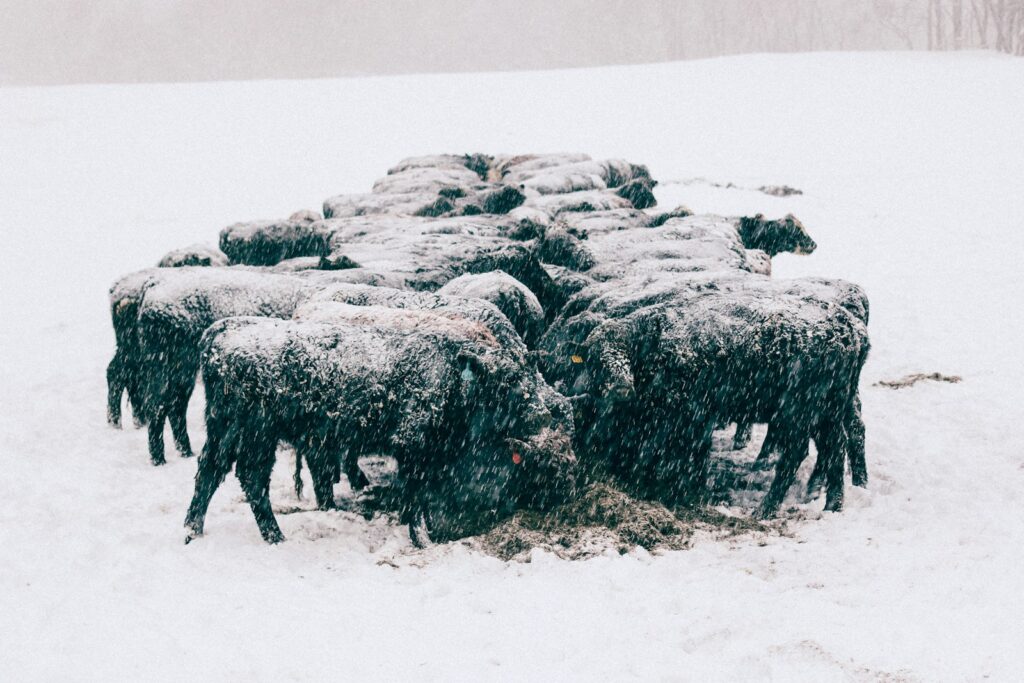
The remarkable winter survival adaptations of bison represent a masterclass in evolutionary design, perfectly tailored to one of North America’s most challenging environments. From their specialized physiology to their sophisticated behavioral strategies, every aspect of the bison’s winter toolkit reflects thousands of years of adaptation to the unique challenges of Great Plains winters. As we work to restore bison populations across their historic range, understanding these winter survival mechanisms becomes increasingly important for conservation efforts and ecosystem management. The bison’s ability to not just survive but thrive through brutal winter conditions stands as a powerful reminder of nature’s resilience—and offers lessons about adaptation that remain relevant in our changing climate today.

